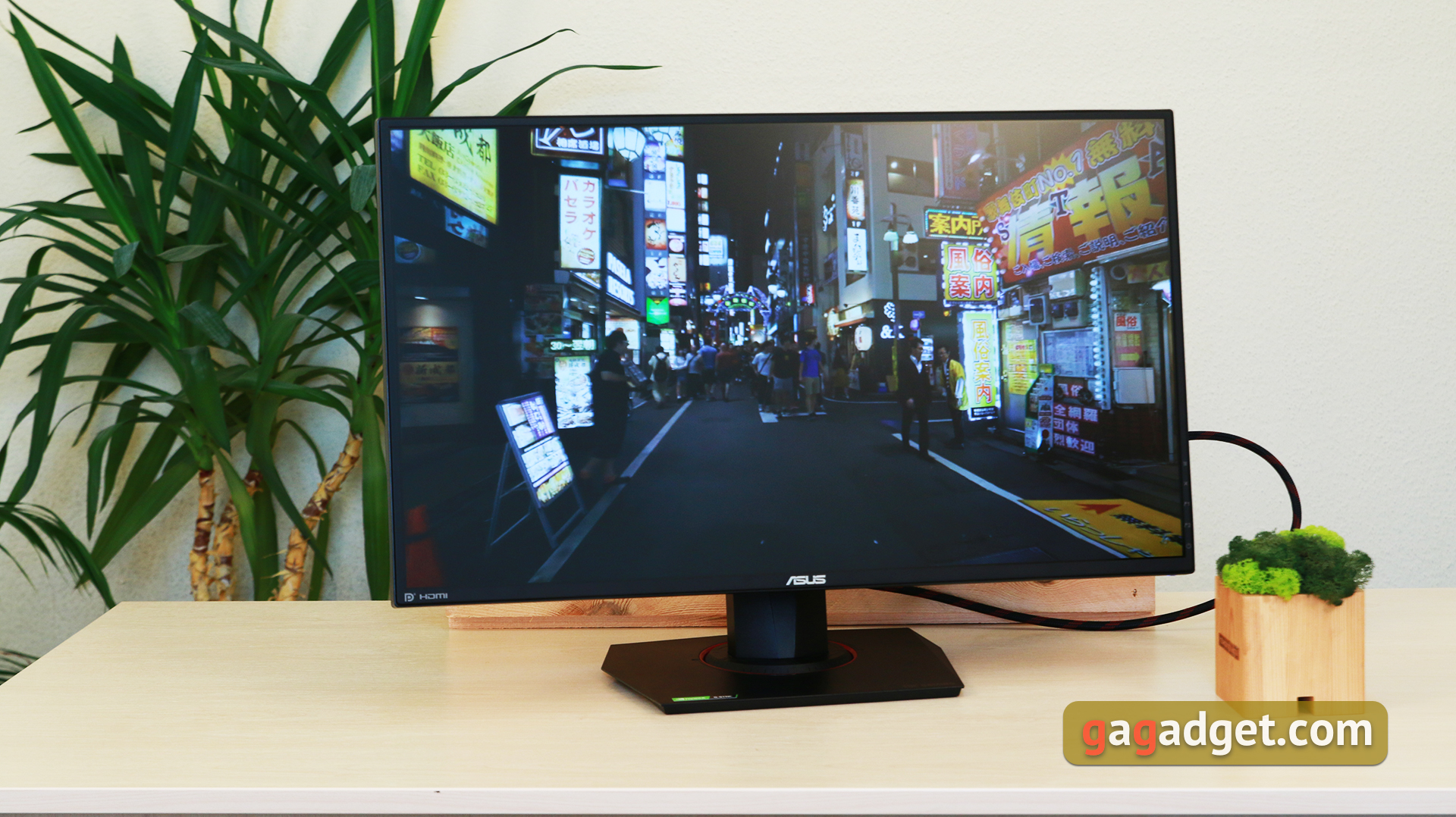
</ img>
Until recently, only
ASUS TUF Gaming VG279QM
Super fast sensor IPS gaming monitor
27 '' IPS FullHD gaming monitor with 280Hz maximum refresh rate, 1ms pixel response time, Adaptive-Sync and NVIDIA G-SYNC support.
Rozetka
MOYO
Foxtrot
Telemart

We recommend
5 reasons to buy ASUS TUF Gaming VG279QM:
- high-quality IPS-matrix with a refresh rate of 280 Hz and HDR support;
- many game modes and additional game functions;
- availability of the necessary video connectors;
- Adaptive-Sync and NVIDIA G-Sync support;
- comfortable design and versatile appearance.
2 reasons not to buy ASUS TUF Gaming VG279QM:
- you are looking for a monitor with a diagonal and higher resolution;
- no USB hub.
Fast passage:
- What is included?
- What does the ASUS TUF Gaming VG279QM look like?
- What with usability, adjustment and connectors?
- How is ASUS TUF Gaming VG279QM with picture quality?
- How did he prove himself in games?
- In the dry residue
What is included?
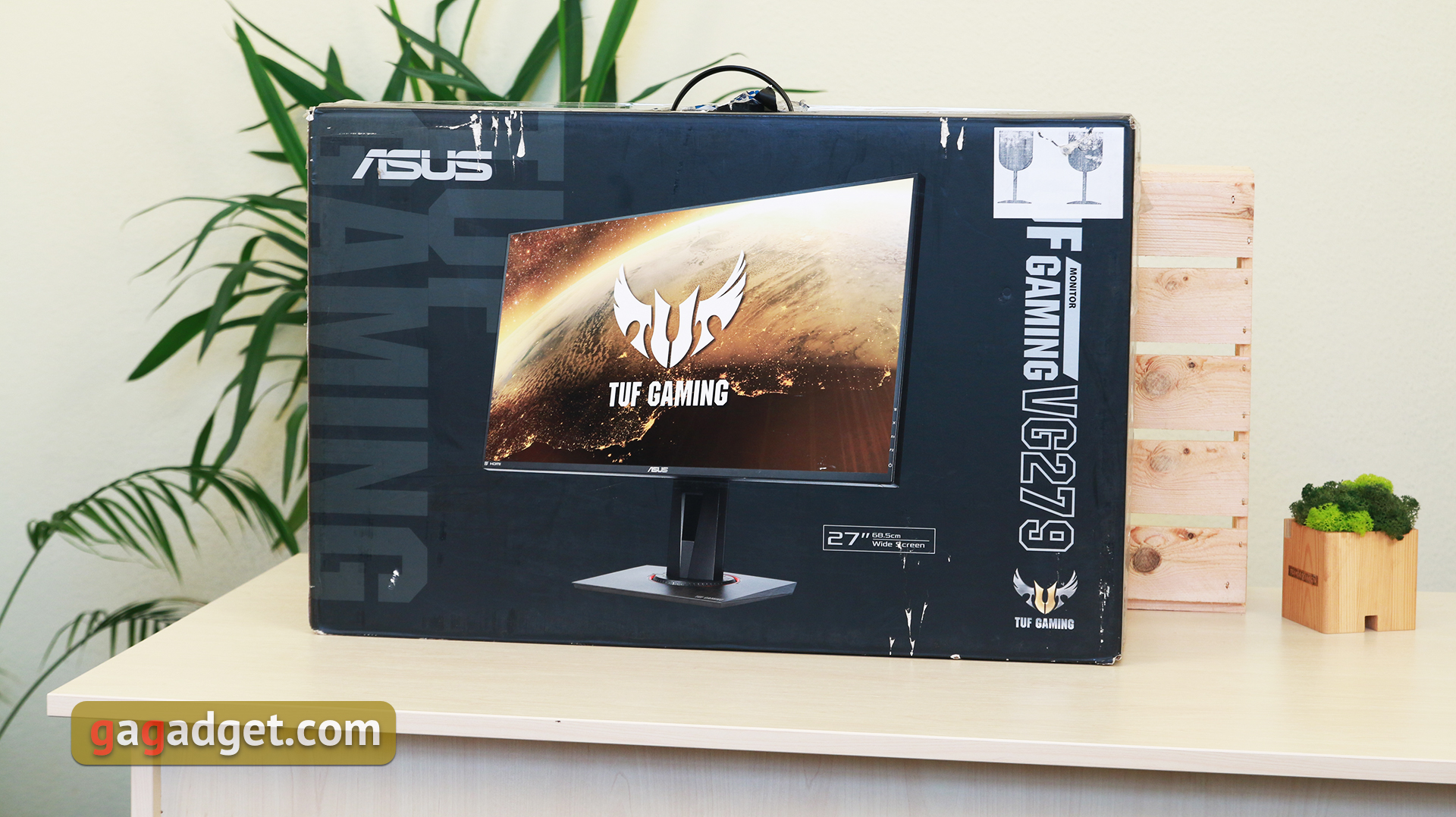
</ img>

</ img>

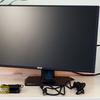
ASUS TUF Gaming VG279QM comes in largea black and gray box with images of the monitor and information about the main technical characteristics. Along with the monitor, the box will contain HDMI and DisplayPort cables, a compact external power supply, a power cable and a set of documentation. HDMI and waste paper did not reach us for review.
</ p>What does the ASUS TUF Gaming VG279QM look like?
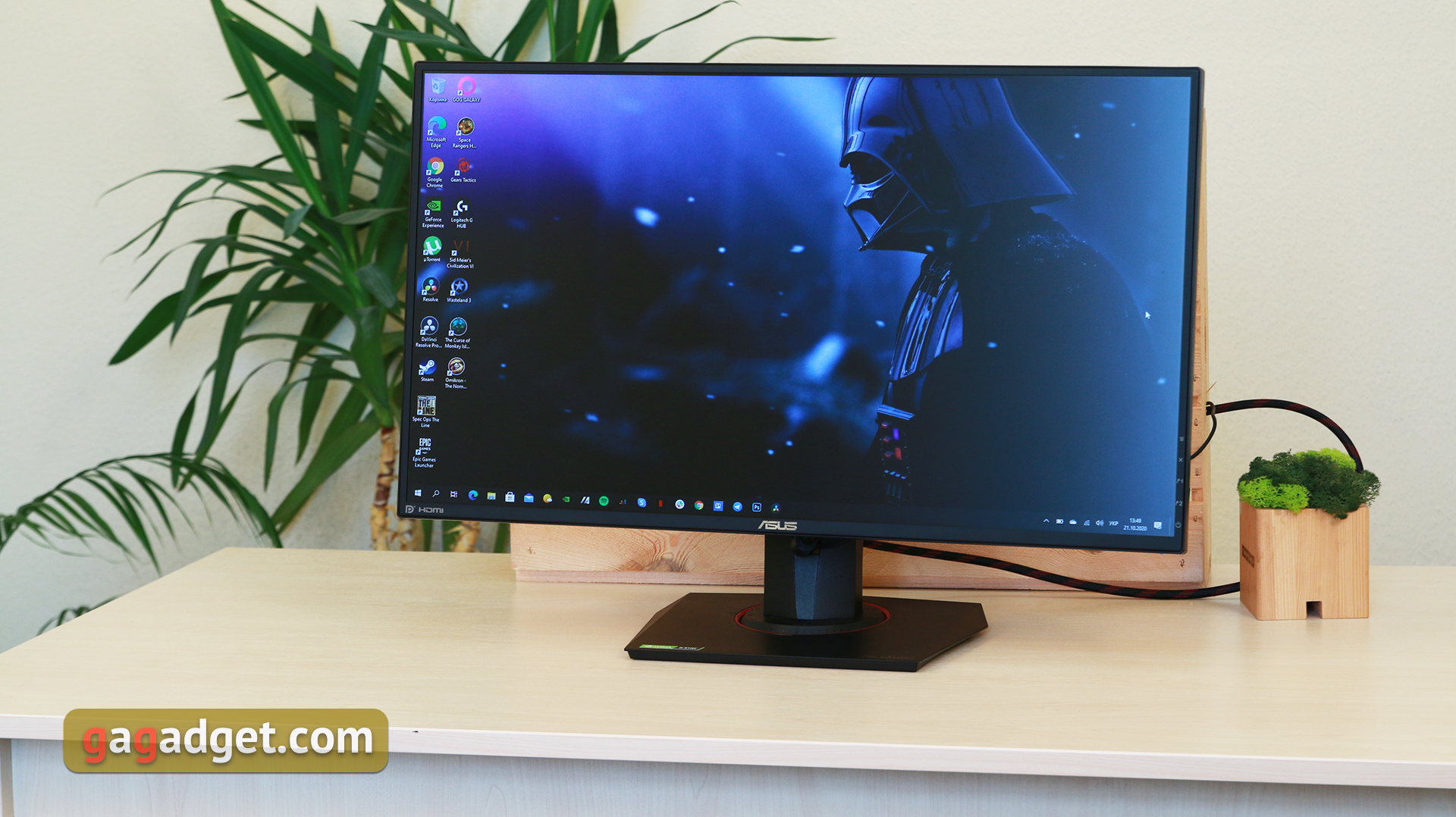
</ img>
The TUF Gaming line stands out as rather discreeta design in which gaming “motives” are recognizable, but there are no frills such as RGB backlighting and other bells and whistles. ASUS TUF Gaming VG279QM continues this tradition. It is almost entirely made of matte, rough plastic. The frame around the perimeter of the screen is quite thin, but the so-called “frameless” design is not used. That is, the sides are physically present. The gaps on the sides and top are about a centimeter. At the bottom there is a little more, a small silver ASUS logo is placed under the screen.
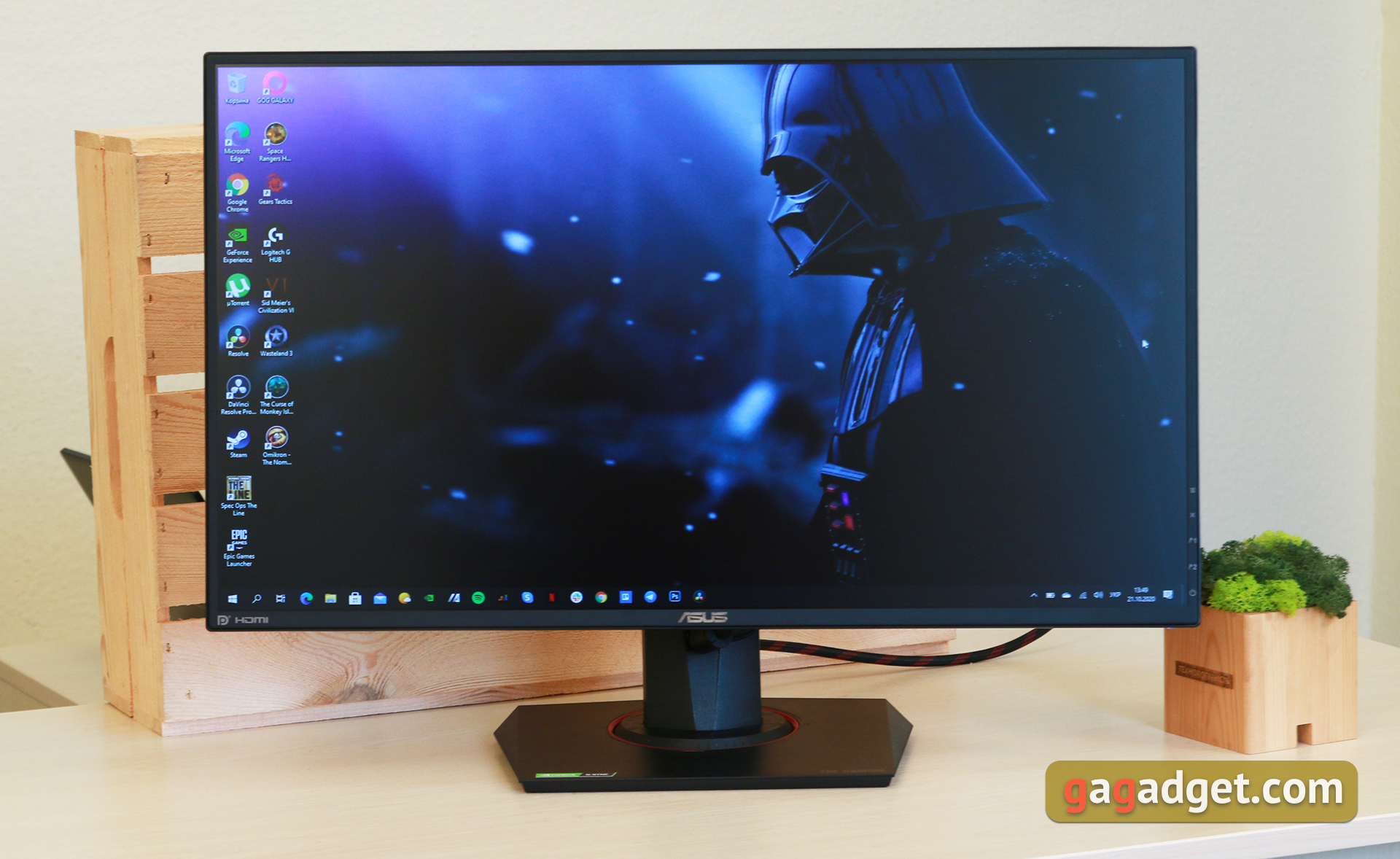
</ img>
Stand of impressive size, trapezoidalforms, like other current TUF Gaming monitors. For greater stability, inside - metal, and outside - black plastic. On the front of the stand is the logo of the line and the NVIDIA G-Sync designation. The base is adjustable: the monitor can be rotated 90 ° to either side. Decorations include red piping and notched patterns at the base.

</ img>
The back of the monitor is also covered with decorativepatterns in the style of ASUS gaming devices. At the top is a large manufacturer logo, and on the top of the stand is the TUF Gaming logo. On this “decoration” are ending. Otherwise, everything is as usual: the stand is attached to the central part of the monitor. It can be removed and the monitor can be hung on the wall; the VESA 100x100 standard is supported. At the bottom of the rack there is a small through hole for cable management.
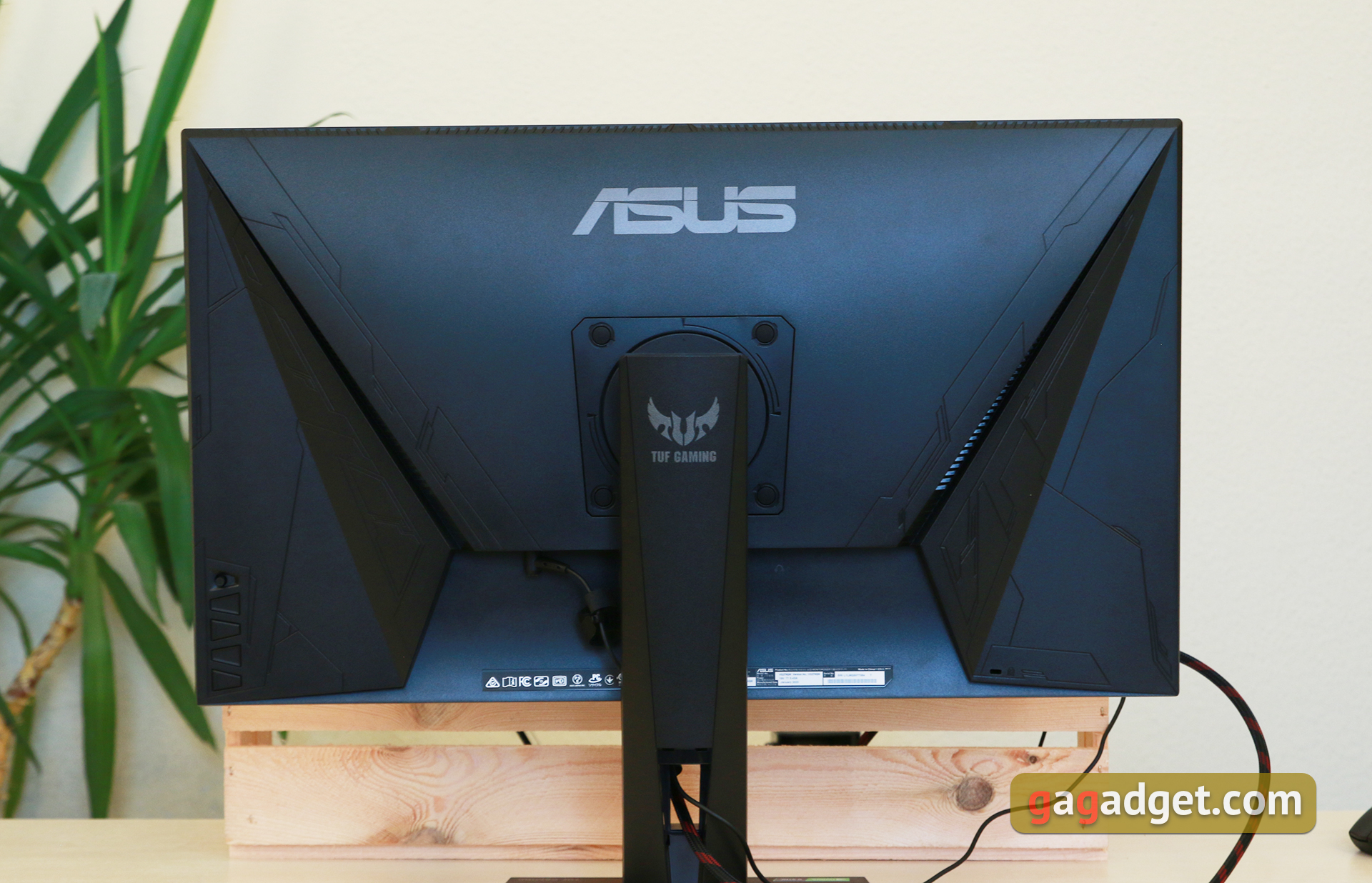
</ img>
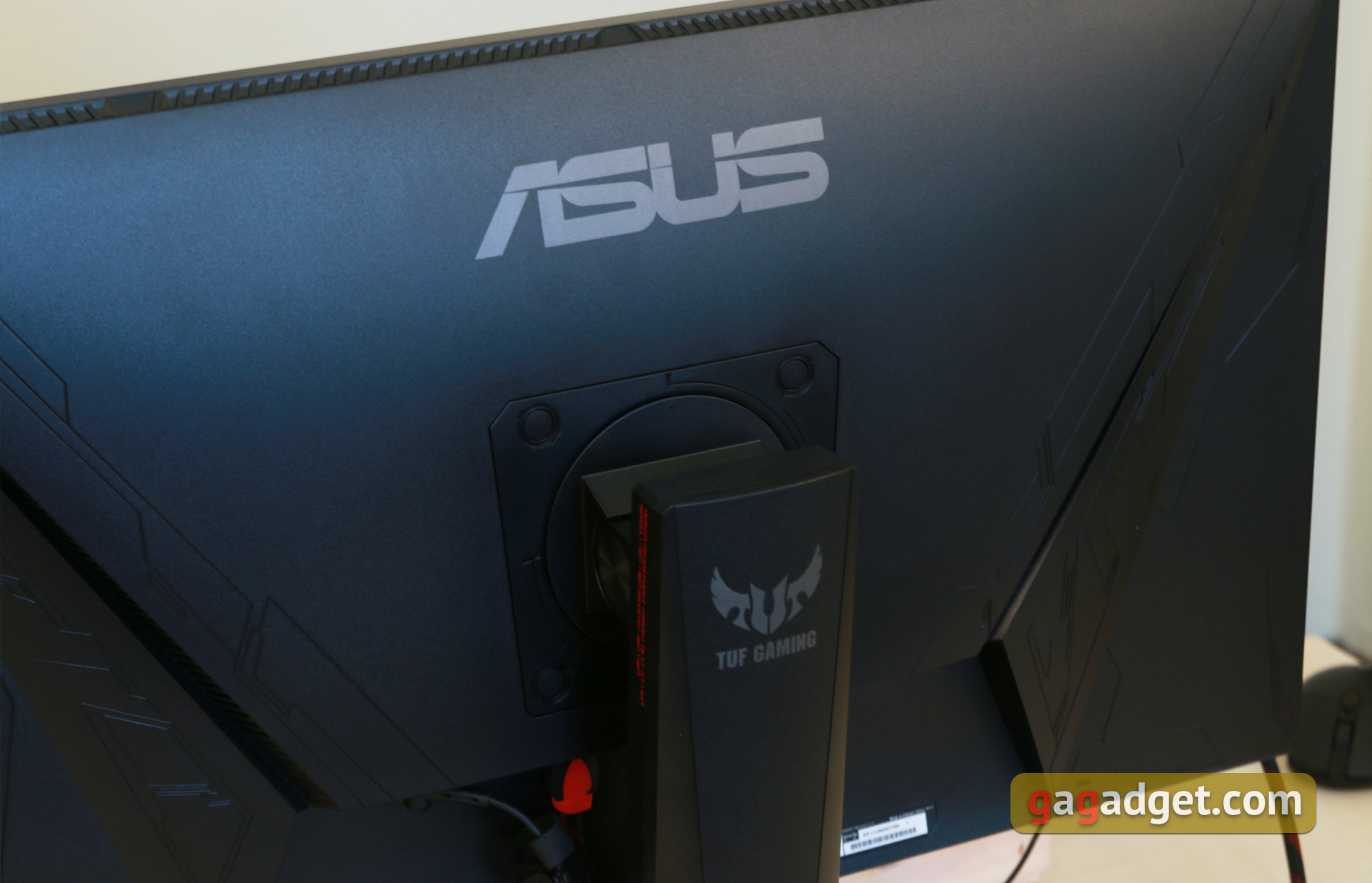
</ img>
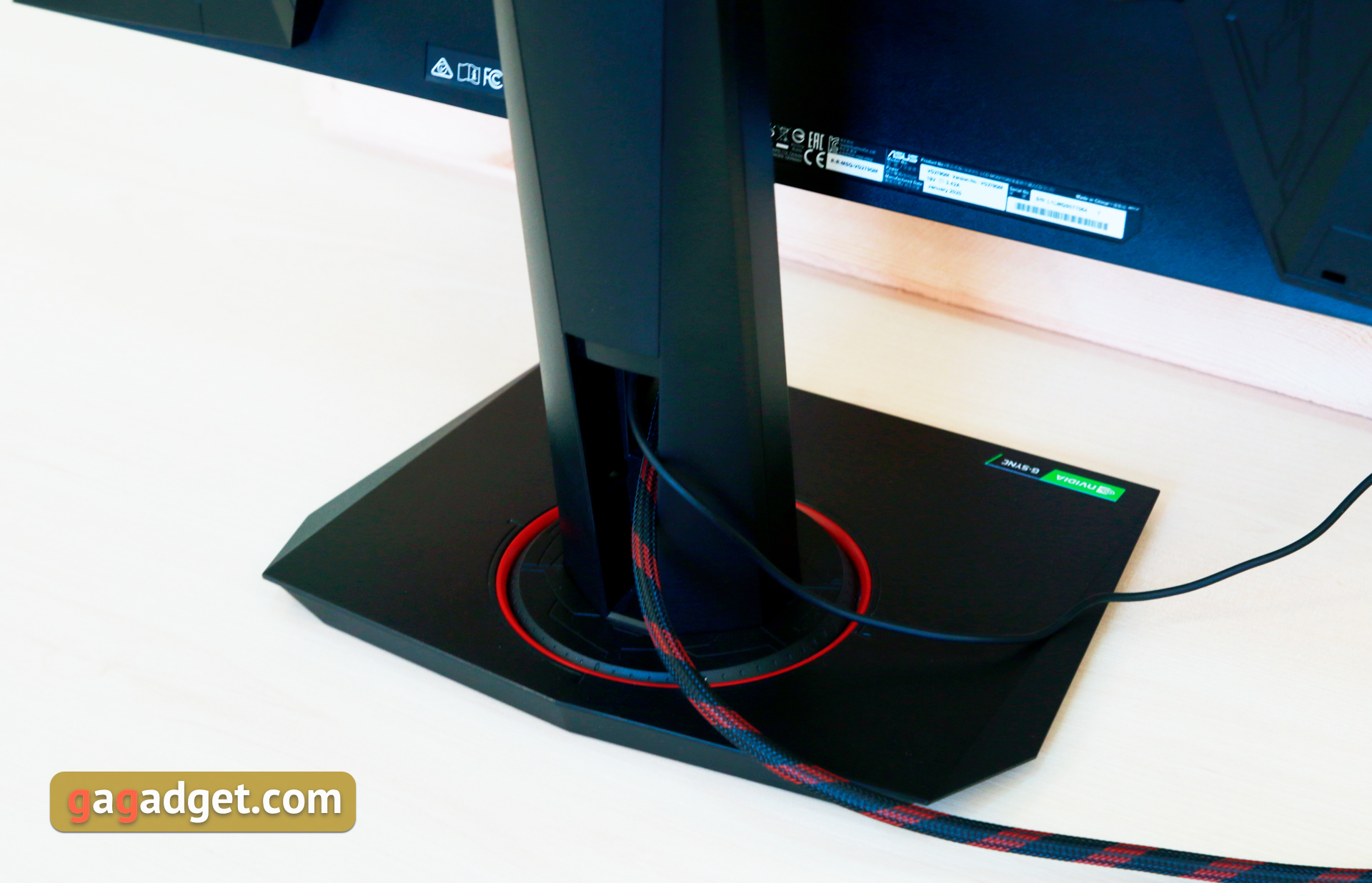
</ img>
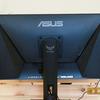


The monitor has a very shallow depth and does not take up much space on the table:

</ img>
Among the functional elements on the rear panel there areKensington Lock slot and control panel. It is similar to other ASUS gaming models. This is a five-way joystick and four physical trapezoidal buttons below it. They are large and easy to find.
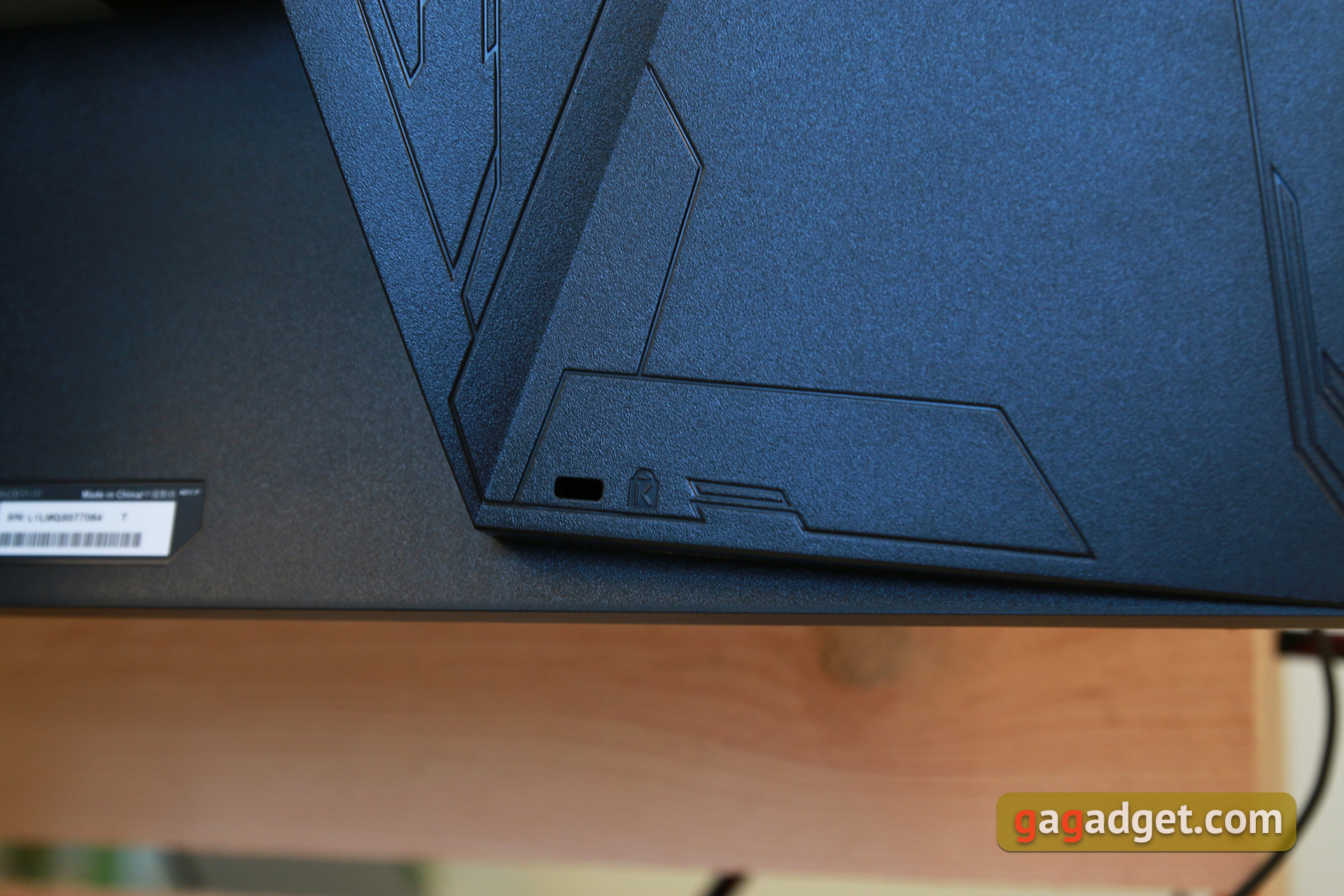
</ img>

</ img>


The panel with ports is located under the rack mount and is directed downward.

</ img>
On the bottom right is a small white LED indicator.

</ img>
The appearance of the monitor turned out quite welluniversal: belonging to the gaming line is visible, but in an office environment the ASUS TUF Gaming VG279QM looks quite harmonious. The assembly and materials are at a good level: no strange gaps between parts or “crunch” The monitor body is not visible.
</ p>What with usability, adjustment and connectors?
Control of buttons and joystick is organizedsimilar to previous models. The joystick is responsible for menu navigation and confirmation. The buttons below are Cancel (also brings up button function labels on the screen), GamePlus functions (crosshair display, zoom, FPS, timer), switching GameVisual game modes, and power. Getting used to this control happens quite quickly. It’s a little more difficult to remember what is where in the on-screen menu. But more on that below.
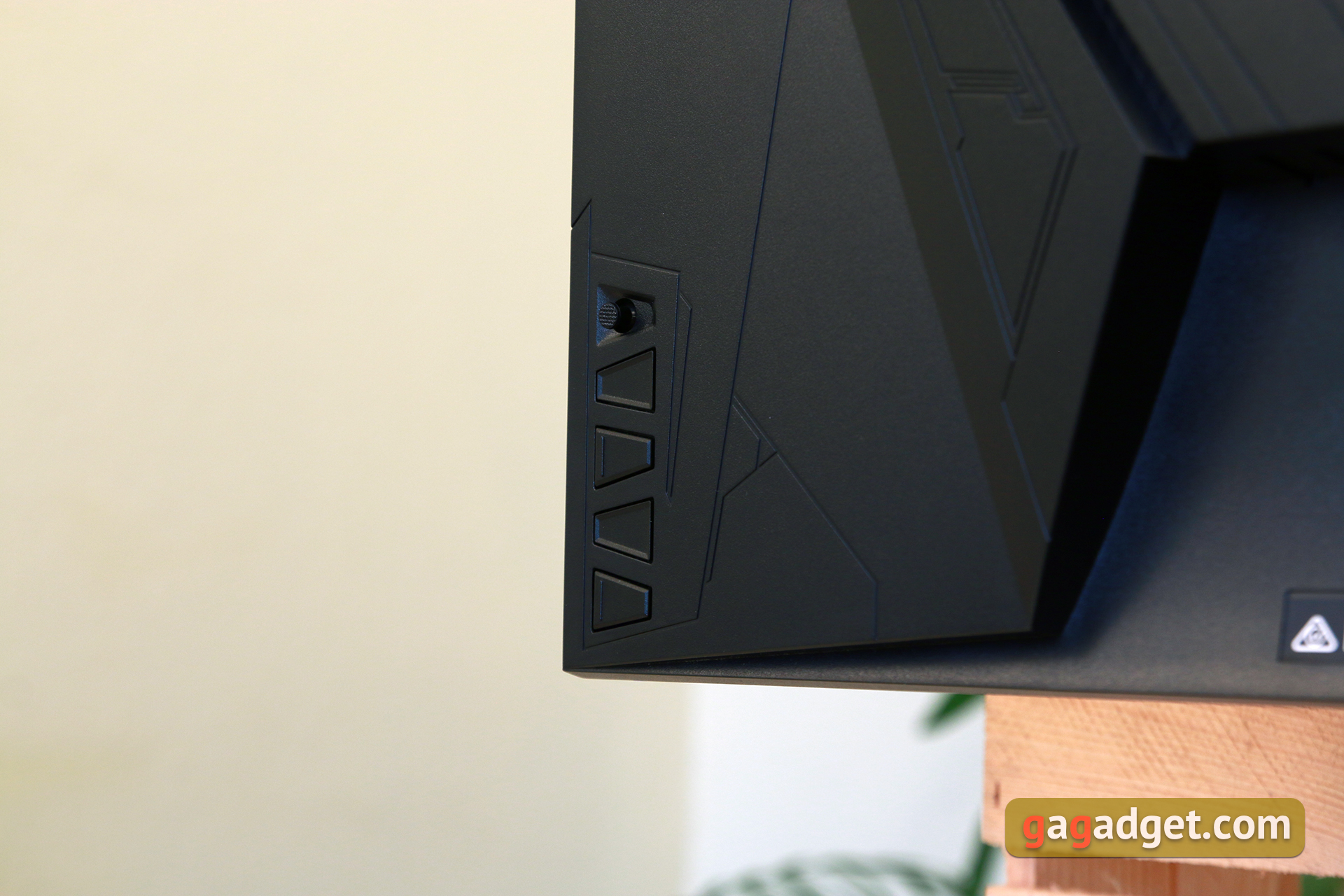
</ img>
On the panel with connectors: a power supply jack, two HDMI 2.0 ports, one DisplayPort 1.2, a standard 3.5 mm audio jack for headphones and (apparently) a service USB connector. There are not so many ports, but everything you need is present.
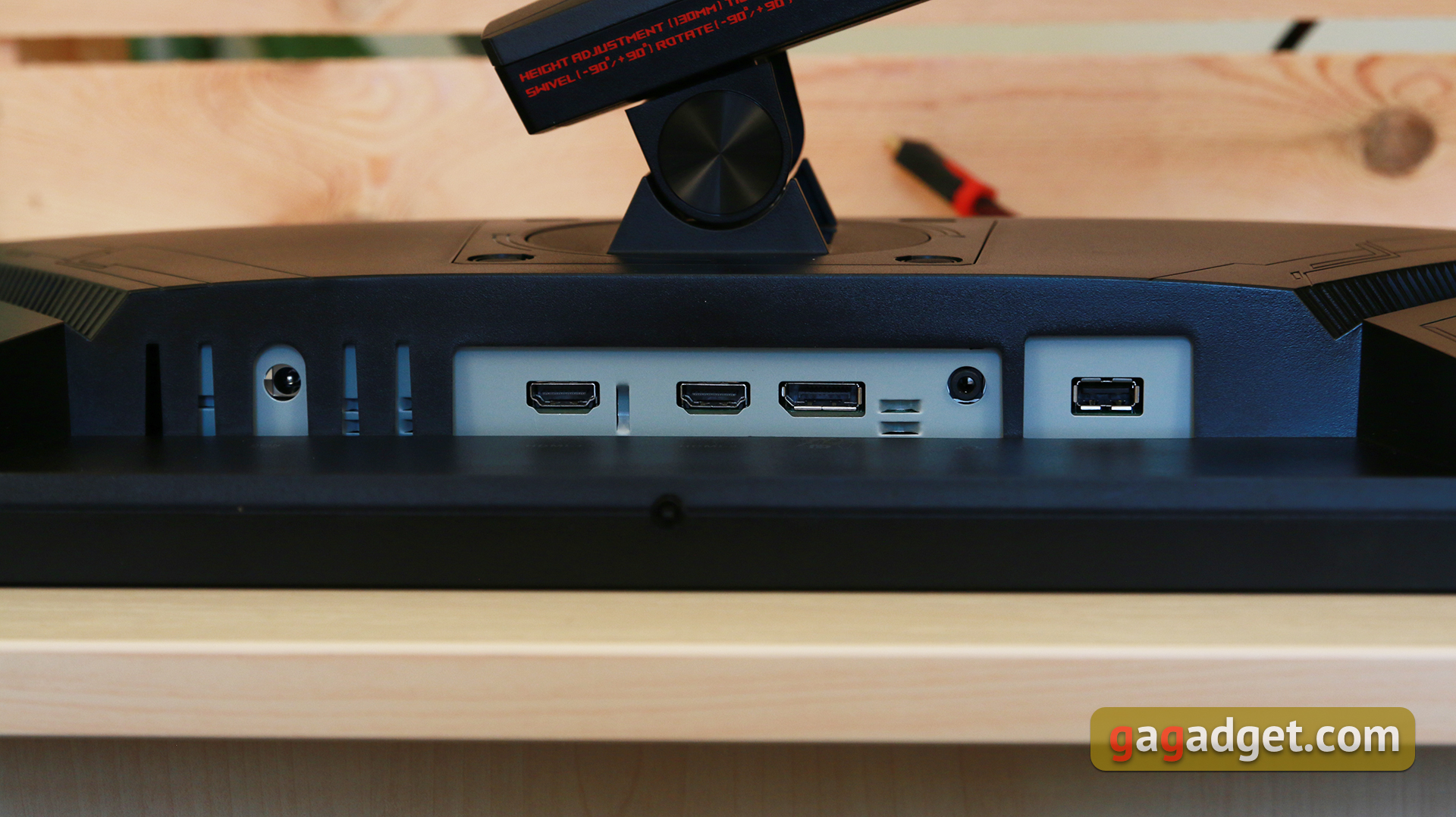
</ img>
All connected cables can be routed neatly thanks to the hole in the foot.

</ img>
The stand allows you to adjust the height with a difference of up to 130 mm. At the same time, in the lower position the monitor practically touches the stand:
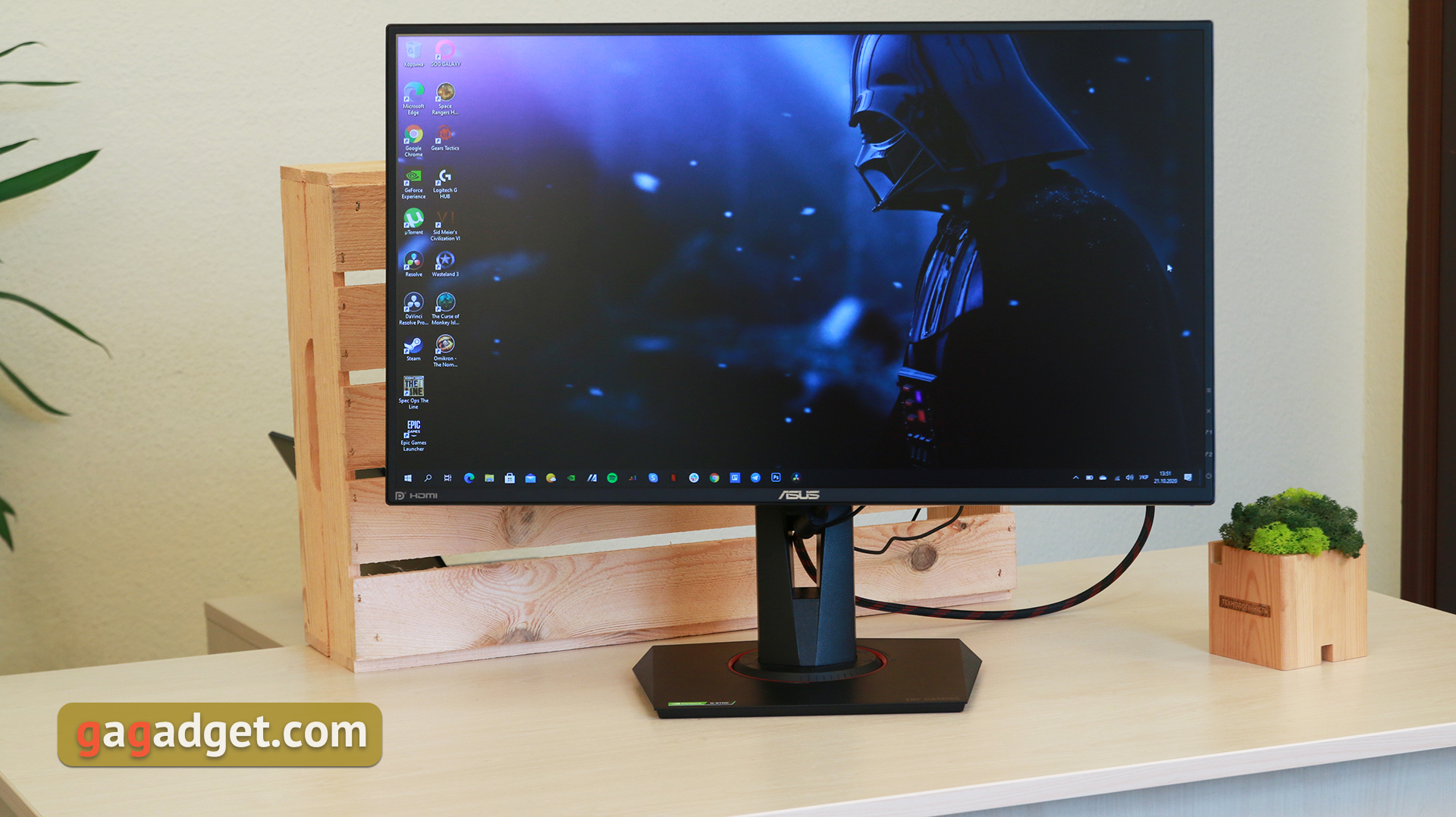
</ img>

</ img>

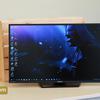
The stand allows you to rotate the monitor 90°. Tilt adjustable from +33° to -5°:

</ img>

</ img>


It is also possible to turn the monitor into portrait mode.
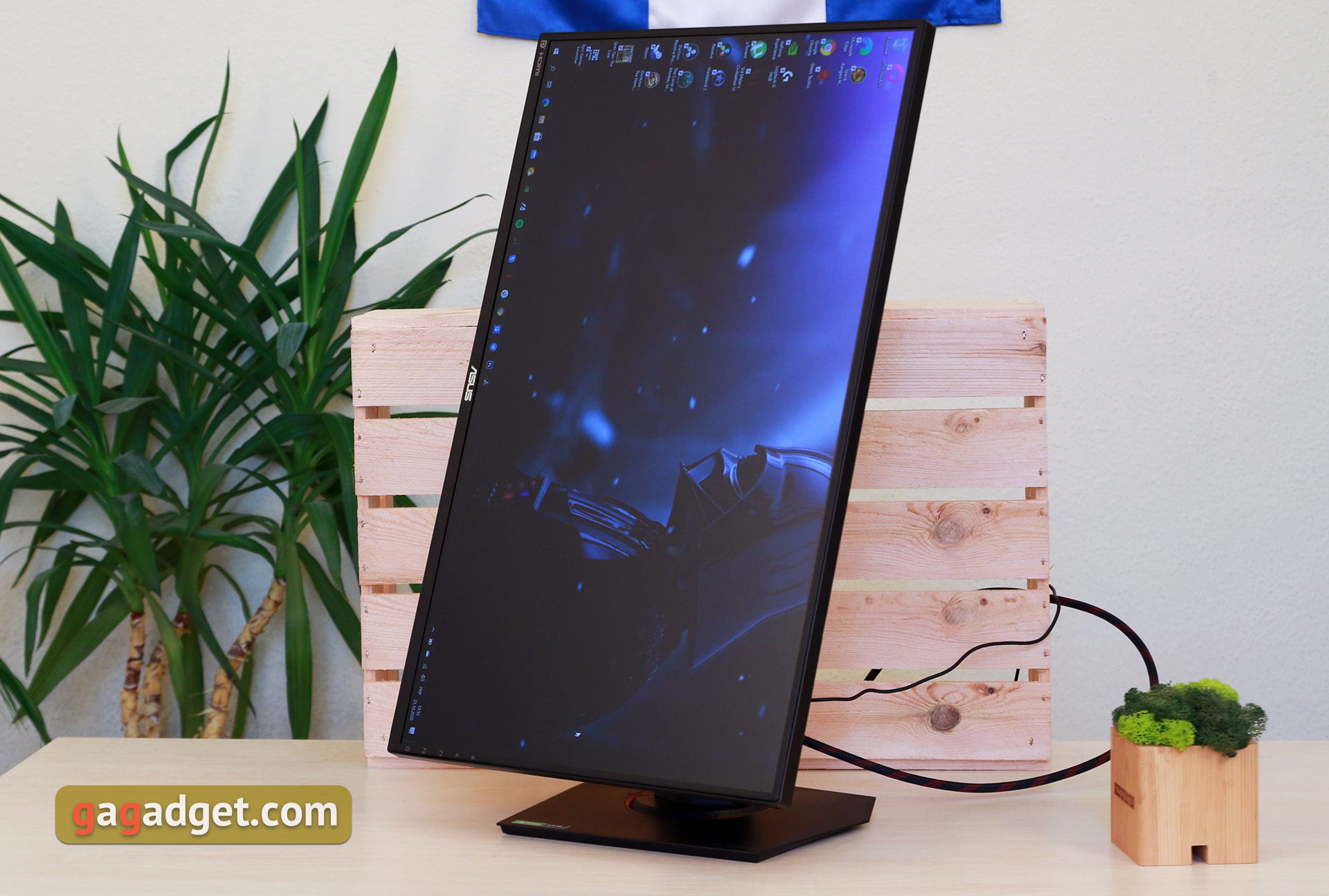
</ img>
Now let's move on to the menu.It is organized quite logically, but the monitor has a very impressive number of functions and additional capabilities. So it will take some time to customize everything to your tastes. At the same time, it is worth remembering that when activating some factory presets, some functions will be inactive. For example, in sRGB mode the brightness is fixed and cannot be changed. The first menu item “Game” is responsible for overclocking the matrix to 280 Hz, overdrive, enabling adaptive synchronization, ELMB SYNC (simultaneous operation of ELMB, low-motion-blur technology and Adaptive-sync), GamePlus functions, GameVisual presets and the ShadowBoost function (lightening dark parts of the picture). The second item called “Image” is responsible for standard settings for brightness, contrast, and so on. Section “Color” Allows you to adjust the color temperature. The purpose of the “Input Selection” section, I think, is already clear based on the name. The MyFavorite section allows you to assign two individual settings presets to shortcut keys. In “System Settings” you can select the language, the menu itself, sound, reset settings, and so on.

</ img>
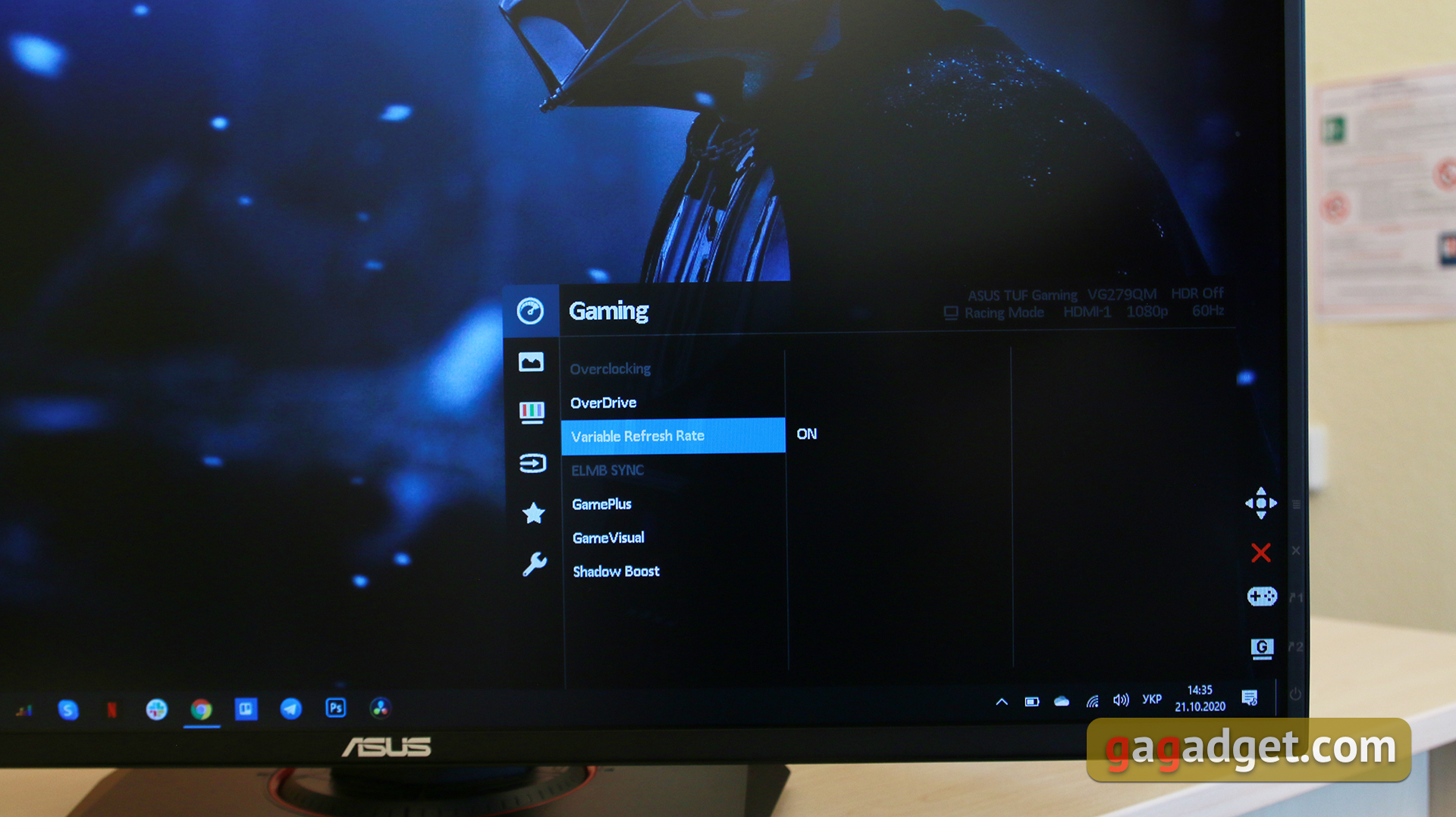
</ img>

</ img>
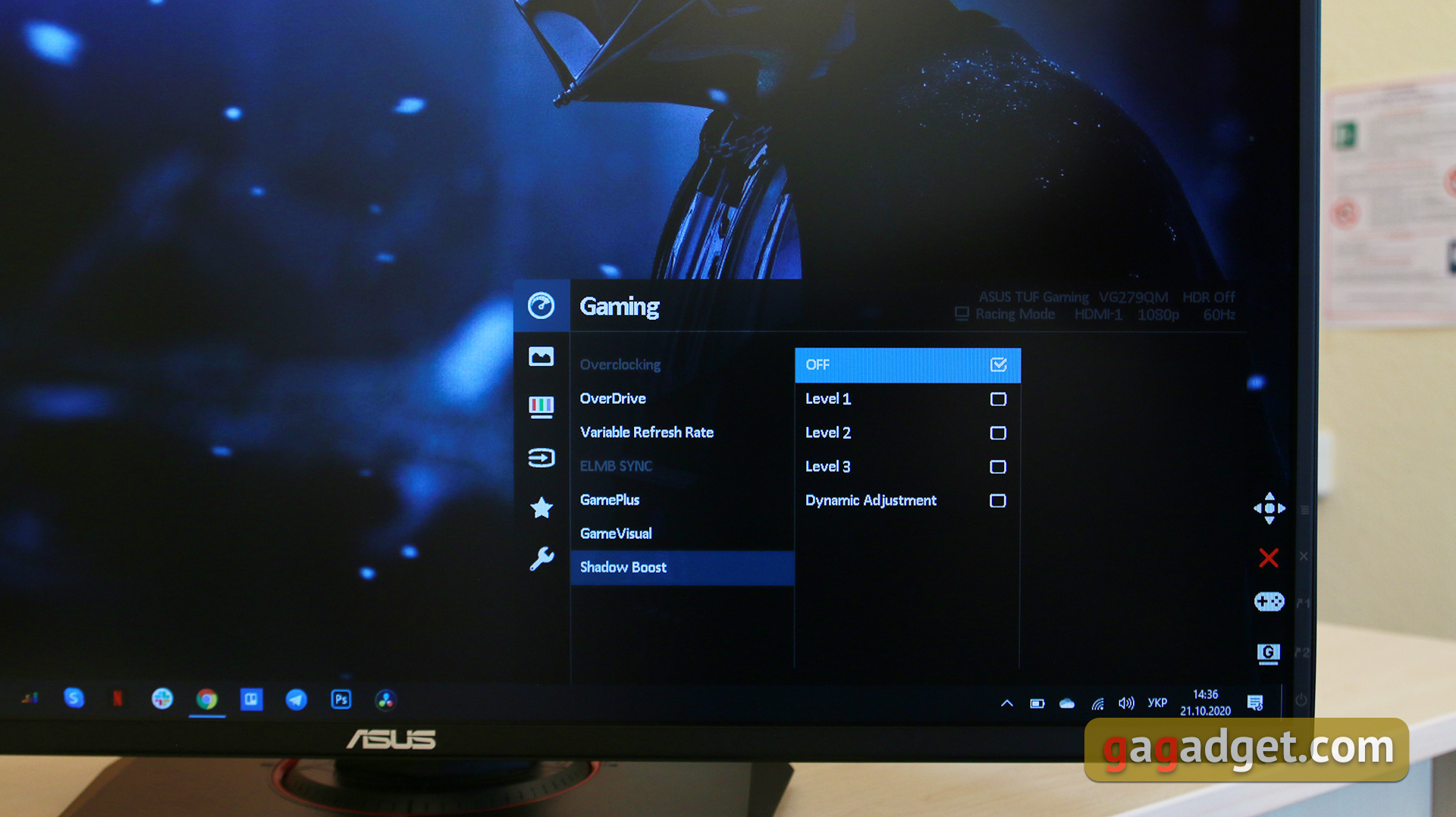
</ img>

</ img>

</ img>
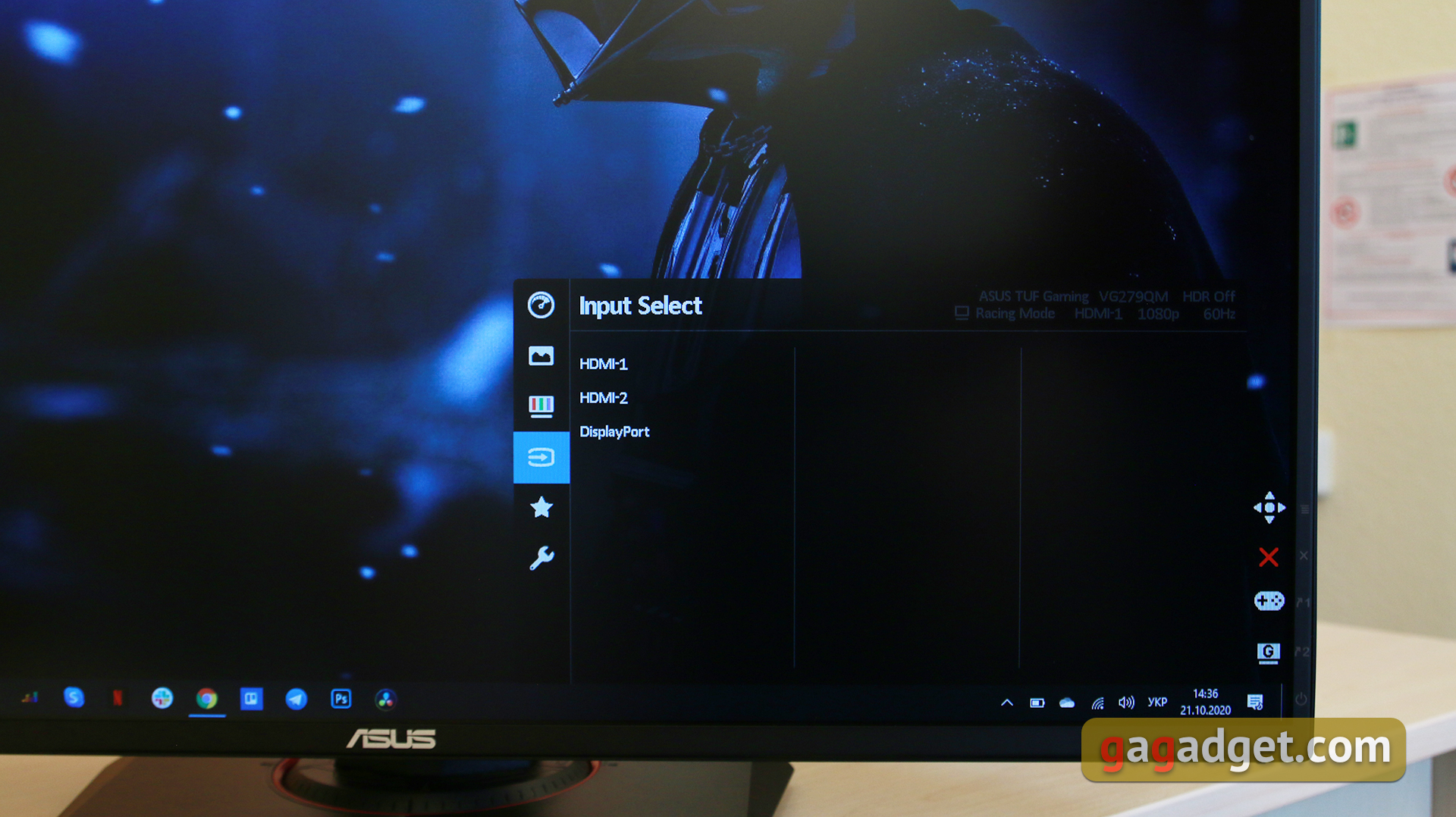
</ img>

</ img>

</ img>

</ img>
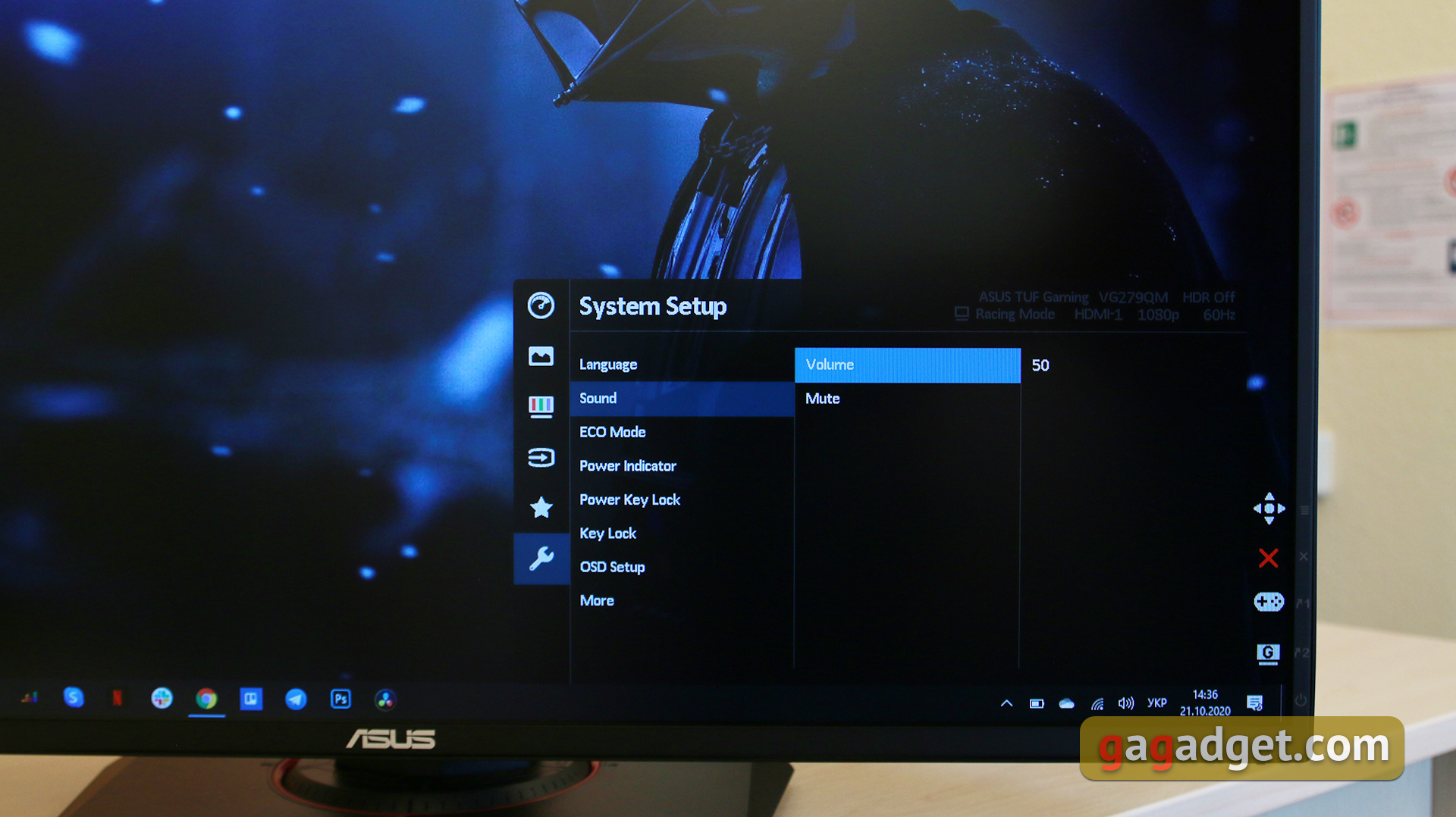
</ img>

</ img>












A few words about GamePlus.This model has the usual functions of an on-screen sight, an FPS counter, a timer, and a utility for aligning the image on the screen. Sniper mode has been added to them with the ability to select a scale. The small rectangular area in the sight area is enlarged. The on-screen crosshair and Sniper mode can be considered cheating, so ASUS calls them Practice Mode.

</ img>

</ img>

</ img>

</ img>

</ img>

</ img>






How is ASUS TUF Gaming VG279QM with picture quality?
ASUS TUF Gaming VG279QM has 8-bit27-inch FullHD AHVA matrix. A variation on the IPS theme from AU Optronics. To be precise, the model used is M270HAN03.0 with W-LED backlight, “native” 240 Hz picture refresh rate and 5 ms response time (gray to gray, GtG). Maximum values of 280 Hz and 1 ms are achieved by overclocking the matrix. The maximum declared brightness is 400 cd/m², DisplayHDR 400 is supported. Other important things worth noting are NVIDIA G-Sync Compatible. But you should understand that this is not the presence of the G-Sync hardware module; synchronization is implemented using the DisplayPort 1.2 interface and GeForce video cards starting from the 10th series with the latest drivers. In addition to this, there are a couple of ASUS developments: Extreme Low Motion Blur to reduce blurring in dynamic scenes, which in this monitor, thanks to ELMB SYNC, can work together with adaptive frame rate. Well, nice bonuses: Flicker-Free (eliminates flicker) and Ultra-Low Blue Light (reduces the intensity of the blue component).
</ p>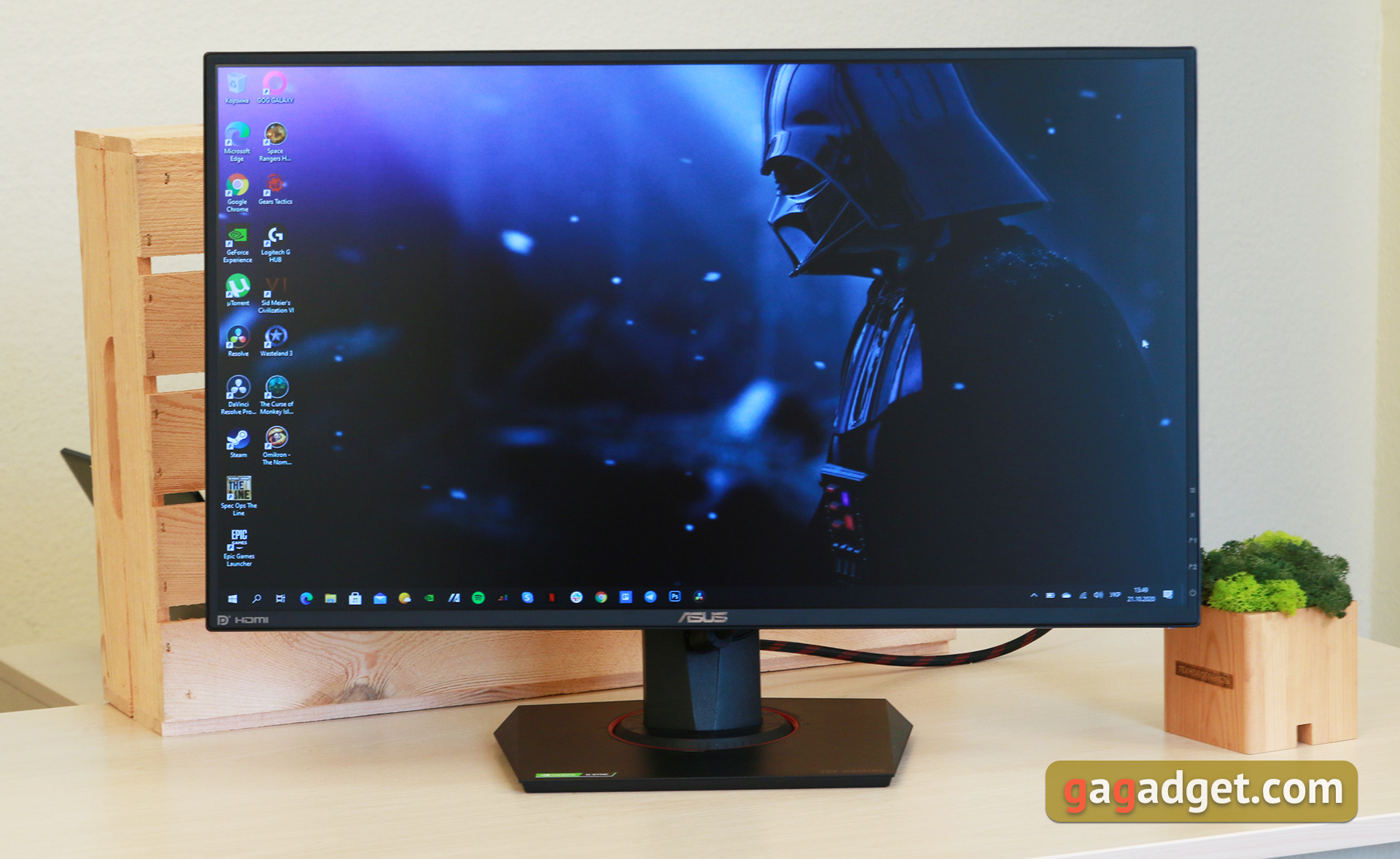
</ img>
As for the picture itself, ASUS TUF GamingVG279QM is completely fine with it. The viewing angles are maximum, both horizontally and vertically. Contrast is reduced very slightly. The glow effect is present, but within the normal range for IPS panels. False shades appear on a dark background at angles, but overall everything is at a comfortable level. There are no critical problems with the uniformity of illumination: even on a black background there are no obvious annoying highlights. Measurements showed that the maximum brightness of the monitor is 412.859 cd/m², the brightness of the black field is 0.409 cd/m², and the contrast ratio is 1009:1, which is very good and corresponds to the stated indicators. These results were obtained in Racing mode. In the rest (except sRGB) the results are similar. Color rendition is also good: the color gamut is almost the same as sRGB, the color temperature is close to 7000K, and the excess of blue is minimal. The average color error ΔE is 3.1.
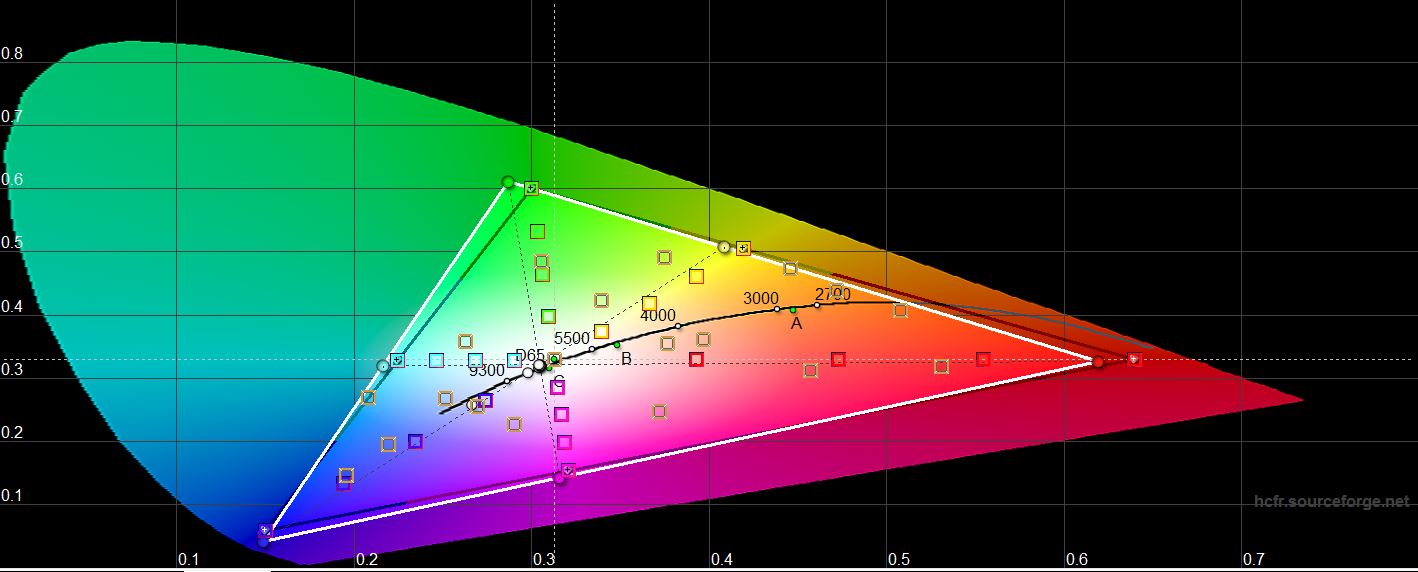
</ img>

</ img>
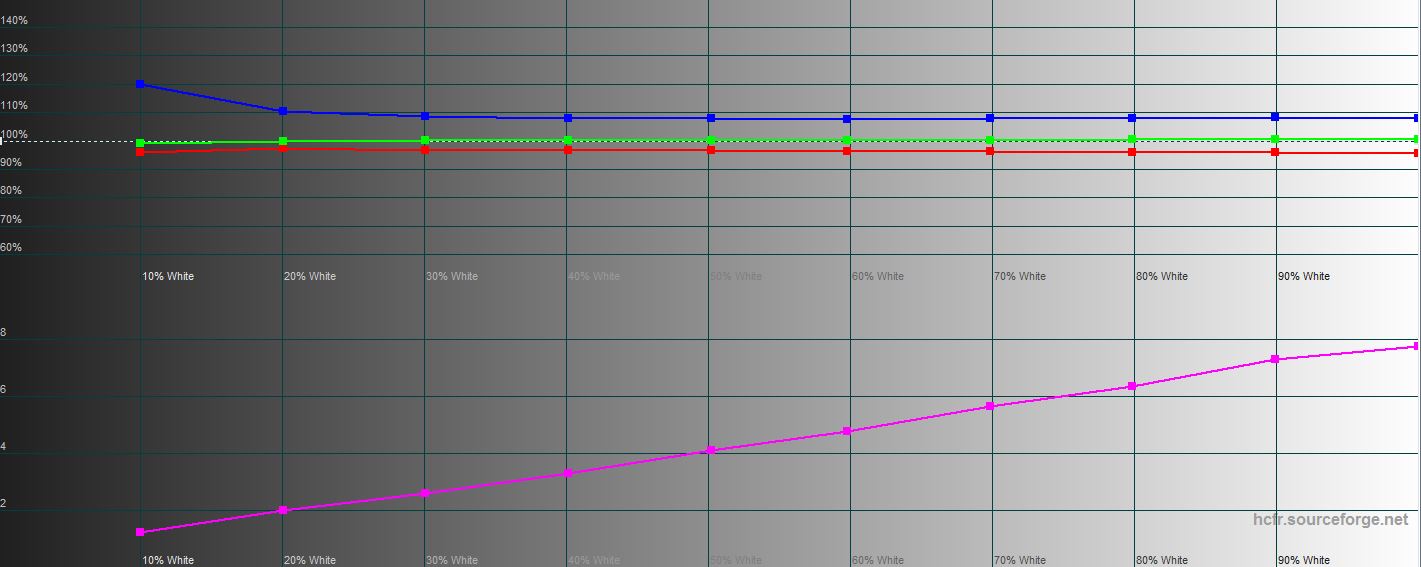
</ img>

</ img>

</ img>





In FPS mode, the brightness is slightly higher: 418.79 cd/m², but color accuracy is slightly worse: color temperature is about 7500K, the gamma curve is quite different from the standard, and ΔE (average) is 3.69:

</ img>

</ img>

</ img>
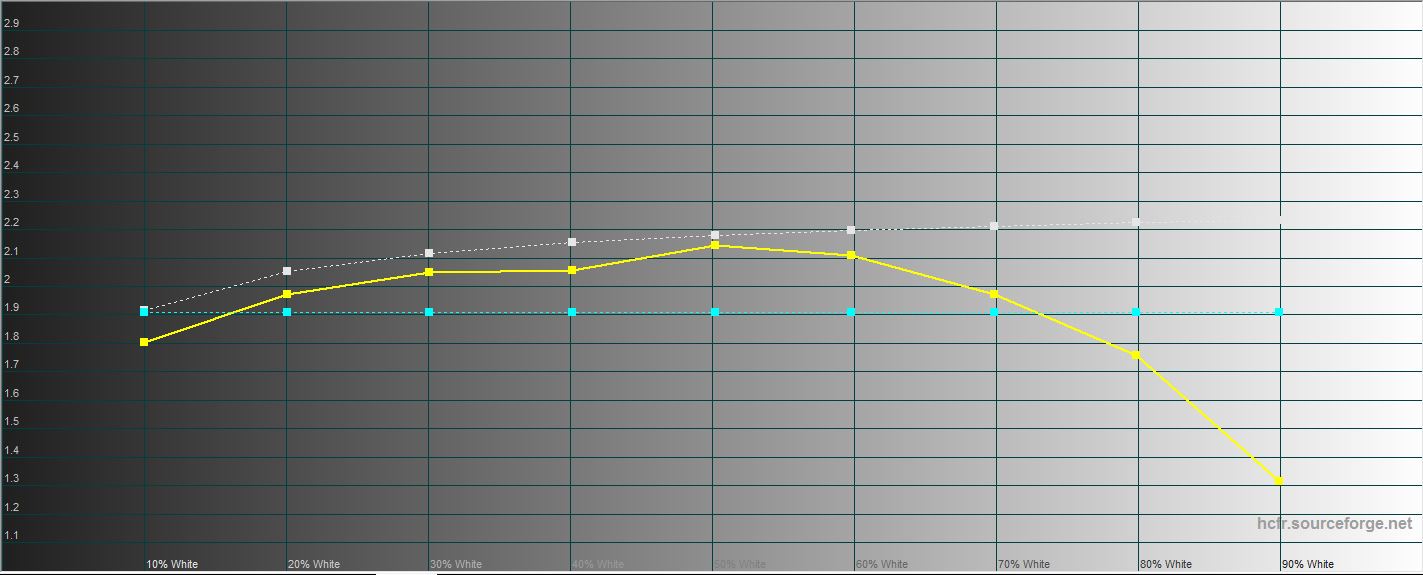
</ img>

</ img>





Closest to reference sRGB mode:the ΔE indicator averages 2.86. But the brightness in this mode is fixed at a very low level of 156.87 cd/m², which is not always enough.

</ img>

</ img>

</ img>

</ img>

</ img>





How did he prove himself in games?

</ img>
In games ASUS TUF Gaming VG279QM showed itselfexcellent with one “but”: with a 27-inch diagonal and FullHD resolution, the pixel density is about 81.5 ppi. And if you watch movies on the monitor from a distance, then everything is fine. But when gaming, we usually sit close to the monitor and the pixels are really visible. On the other hand, this is quite normal for a gaming model: at a higher resolution, in order to get the coveted high frame rates, you need more powerful hardware, especially if you mostly play modern games. We “drove” On the monitor there are mainly fast first-person shooters, such as DOOM Eternal, CS:GO, Call of Duty: Modern Warfare, in which frame rate is especially important. There are no obvious artifacts, breaks or loops. As for GamePlus gaming gadgets, the FPS counter can be useful. Possibly a timer. And the on-screen sight and sniper mode with an increase in the area in the center of the screen are very doubtful. Although it is possible that someone will use it.
</ p>The bottom line is. Three things you need to know about the ASUS TUF Gaming VG279QM:
- the monitor is equipped with a high-quality IPS-matrix with a maximum refresh rate of 280 Hz in overclocking (240 Hz is the native frequency) and a pixel response time of up to 1 ms.
- there are 2xHDMI 2.0, DisplayPort 1.2, 3.5 mm audio jack for headphones, but no USB hub.
- The monitor supports Extreme Low Motion Blur, G-Sync Compatible and ELMB SYNC.
Specifications ASUS TUF Gaming VG279QM
Diagonal
27″
Matrix type
AHVA IPS
Aspect ratio
16:9
Resolution
1920×1080
Contrast
1000:1 (max)
Viewing angles
178 / 178
Colors displayed
8 bit
Pixel pitch
0.311×0.311 mm
Response time
1 ms (GtG)
Brightness
400 cd/m2 (max)
Maximum refresh rate
240 Hz (280 Hz Overdrive)
Coating
anti-glare
Connectors and ports
2xHDMI 2.0, DisplayPort 1.2, audio 3.5 mm, Kensington Lock
Wall mount
VESA 100×100
Built-in speakers
2x2 W
Size (with stand)
619.4×376.73-506.73×211.37 mm
Weight (with stand)
5.6 kg

For those that want to know more:
- Philips Brilliance 499P9H review: 49-inch aircraft carrier monitor
- AOC CQ32G1 review: 32-inch curved gaming monitor with 144 Hz
- Acer Predator X27 review: dream gaming monitor
- ASUS ROG Swift PG258Q review: a 240 Hz gaming monitor for hardcore gamers
- Review ASUS ROG Strix XG32VQ: 32-inch curved gaming monitor with a frequency of 144 Hz